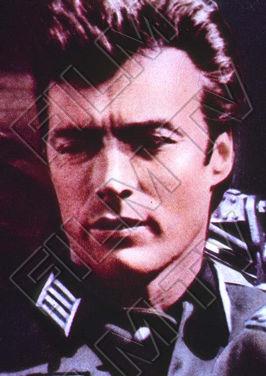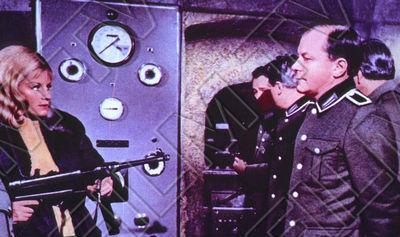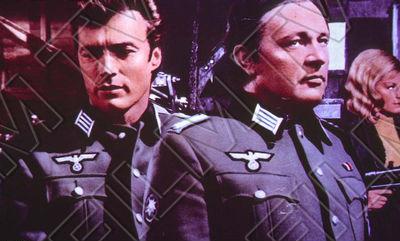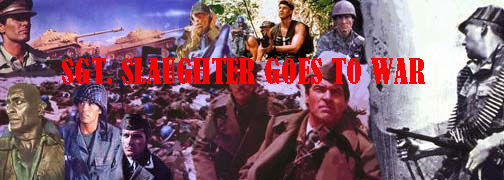
WHERE EAGLES DARE (1968)
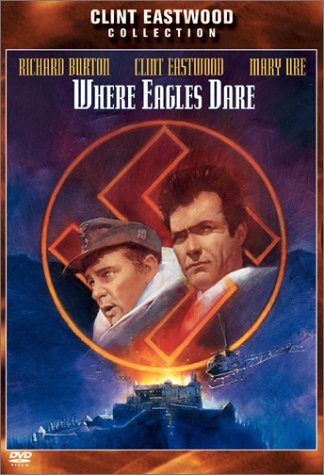
DIRECTOR: Brian G. Hutton
CAST: Richard Burton, Clint Eastwood, Mary Ure, Michael Hordern, Patrick Wymark, Anton Diffring, Robert Beatty, Donald Houston, Ingrid Pitt, Ferdy Mayne, Derren Nesbitt, Peter Barkworth, William Squire, Neil McCarthy, Brook Williams, Victor Beaumont and John G. Heller
REVIEW: An exciting, tense and action-packed British-American thriller with a great leading cast, plenty of familiar supporting actors and some stunning stunt sequences.
In 1944, a British commando team, along with an American OSS operative, parachutes into the Bavarian Alps to rescue an American officer from an impregnable castle. But that's not all that's really going on, and soon the mission is complicated by a traitor in the midst.
Richard Burton (Raid on Rommel) is excellent in an easygoing role as Major Smith, cool and competent commando officer. It's not his best performance - Burton is best suited for large, talky roles - but he appears to be having plenty of fun. Eastwood (Kelly's Heroes) has a seemingly pointless role - until the second half of the movie, when his talents as an assassin are portrayed full-blast. He kills dozens upon dozens of enemy troops, the bulk of them in an impressive hallway shootout which forgets logic and proves that in Hollywood, the good guys always win. In support, Mary Ure is a blonde heroine; Michael Hordern the sensitive British commander; and Anton Diffring (The Fifth Offensive); Derren Nesbitt (The Blue Max) and Ferdy Mayne are the 1-dimensional, evil Nazi officers. The commando team is made up of familiar British co-stars Donald Houston (The Longest Day); Peter Barkworth; William Squire; Neil McCarthy (Zulu) and Brook Williams (The Sea Wolves). Watch for Victor Beaumont as the German colonel who takes the commandos prisoner, and John G. Heller has a one-liner as the German Major in the bar.
The movie's real stars, however, are the great action sequences. The movie features five spectacular scenes: the first two being nail-biting treks across a valley on the roof of a German ski lift, one of which has characters fighting eachother with ice axes; the third being a series of shootouts and booby trap explosions within the bowels the castle; the fourth, a car chase through the center of a German village and down a precarious, snow-covered mountain roadway as German cars and motorcycles pursue a bus occupied by the heroes; and, finally, a huge explosive finale in which the good guys destroy an entire airfield while making an escape to Britain. Each scene is packed with expert camerawork, great stunts and plenty of explosions and loud machinegun fire.
The third strongpoint is the script and story. Alistair MacLean's screenplay, based on his own novel, is excellent. There are plenty of plot twists to keep you guessing as to who is really a good guy and who is really a bad guy. The pacing is perfect; the movie is just the right length, despite the fact that it's over 150 minutes long. Finally, there is a great - but not entirely unexpected - surprise ending which will make you gasp as everything comes together.
There are a few other technological aspects of the film which donít fall into specific categories. First of all, the scenery is never less than stunning. The snowy exteriors have a beautiful look and deeply contrast the violence occurring in and around them. The castle is appropriately dark and foreboding, adding to the "evil" Nazi presence inside. Ron Goodwin's classic score is one of my all-time favorite pieces of music. It adds a sharp edge to the suspense. There are innovative props, too, including some package explosives complete with an easy-to-set built-in timer and tripwire - the perfect item for any commando (or even wannabe commandos).
Where Eagles Dare is a fantastic Hollywood entry which paints a picture of cinema transition. The action is logic-defying in a way not seen until the late 1960s, when Hollywood began turning away from dramatic pieces all about the story to impressing younger audiences with car chases and violence - what rules cinema today. It was happening in westerns with the revisionist "spaghettis"; in the long-running James Bond series with the "license to kill" motto; and, finally in the war film. It's a product of it's time which stands up quite well today.
SGT. SLAUGHTER'S RATING: 4.5 Bullets
